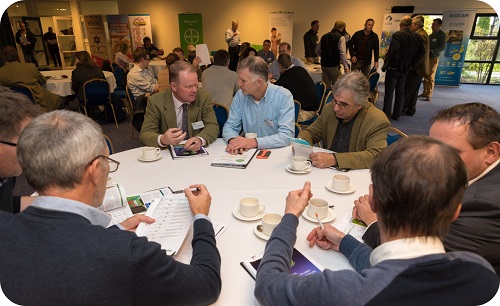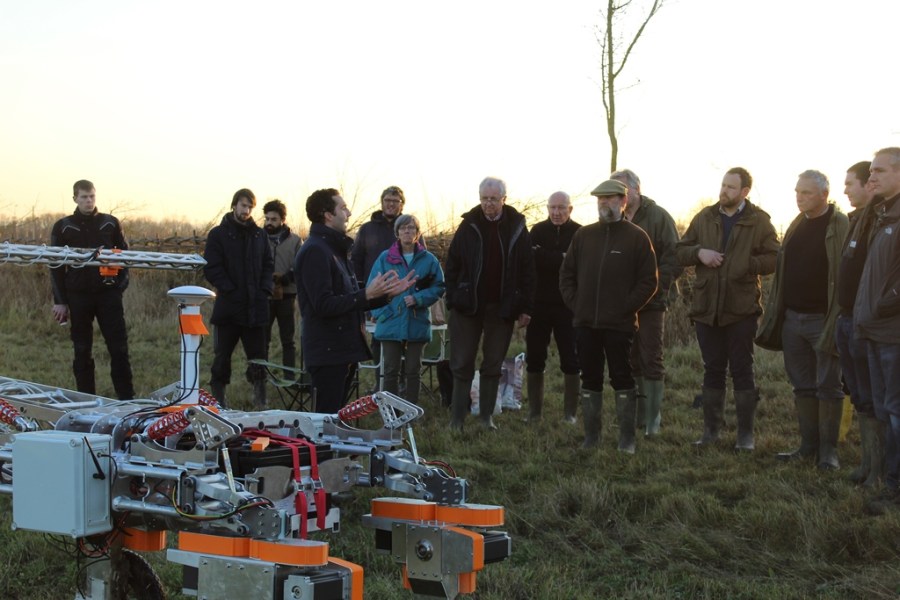On-farm innovation is set to get the co-design treatment currently being applied to the ELM Scheme and other aspects of Defra’s dealings with agriculture. CPM finds out what’s in store and how to get involved.
It’s really about putting farmers and growers into the driving seat.
By Tom Allen-Stevens
On-farm science could be on the threshold of an exciting new era, and it’s one in which farmers, rather than academic institutions, will be taking the driving seat. Not only that, farmers will be co-designing how the new plan will come together, and there’s government cash pledged to see it to fruition.
Defra’s new R&D Innovation package is due to launch next year. It forms one of the measures to improve farm prosperity in its Agricultural Transition Plan, unveiled in Nov. More detail was revealed at the Oxford Farming Conference last month on how the government sees its Path to Sustainable Farming pave its course, and one thing was made very clear – this is not a plan that’s coming together behind closed doors. From Environmental Land Management (ELM) to new entrants, research to regulation, farmers are part of a co-design process.

The government want farmers to be involved in the iterative co-design process, a radical departure from its previous top-down approach to designing schemes.
But what does this actually mean when it comes to on-farm R&D, and what can farmers expect? CPM asked Defra Secretary of State George Eustice for clarification:
“While we have some fantastic academic institutes there’s always a danger that if funding is channelled through universities, and they recruit farmers to participate in research, you can end up with research that is very interesting but that’s too far from the market to be of much use to agriculture,” he says.
It’s this he blames for knowledge transfer not happening as well as he feels it should. “What we envisage is that groups of farmers in a particular sector – let’s say maybe the sugar beet industry – would come together and decide that they were going to really work on an approach to virus yellows, for example, and how they’re going to tackle that challenge.
“They might put some of their own money into that and could qualify for a grant from government as well to support R&D that their own agronomists would then commission from universities, that they thought had something to add.
“So it’s really about putting farmers and growers through syndicates or joint ventures into the driving seat of R&D and allowing them to use funds to actually do things like plant breeding that have got a much better application closer to the market.”
Defra’s also provided CPM with more information on how it sees the R&D Innovation package coming together and the roles specifically it envisages farmers will take within this. The process of its co-design is already underway, and government is keen to involve a wider group of farmers, advisors, scientists and agri-food specialists in workshops and events due to take place over the coming months.
So if getting involved in this new way of working appeals to you, what does it involve? Head of strategy in Defra’s future farming programme, Jonathan Baker and Neville Cavendish, head of co-design, provided an insight at a fringe event of the Oxford Farming Conference with an update on the Test and Trials (T&T), that have put co-design through its paces. CPM caught up with them afterwards to get further detail.
“We’ve undertaken 72 T&T to date, with over 3500 farmers involved in the live tests. 14 of the T&T have been in the arable sector,” reports Jonathan. “We are about to launch a further round of T&T, looking at long-term landscape recovery projects.”
T&T have addressed priority themes, such as land management plans, the role of advice and guidance, and payments. The feedback from those involved has informed how the ELM National Pilot will take shape, due to start later this year and set to bring in 5500 farmers.
“The approach in T&T has been very much ‘bottom-up’, developed in collaboration with farmers. The pilot will be introduced in the form we see the ELM Scheme being delivered – a bit like a beta version.”
Those familiar with Countryside Stewardship (CS) will recognise some elements in how you apply, the guidance, advice and restrictions, particularly on the Sustainable Farming Incentive (SFI) side. But Jonathan says some elements will be completely new and there’s a whole new approach in SFI.
“One of the things we’ve learnt is that on farm, different activities work better if done alongside some other activities. SFI will encourage farmers to follow standards which combine a range of complementary activities we know go well together and are effective. We’re looking to support positive activity in a different way. More information about SFI will be set out in June.”
Work is underway with Defra’s digital section on a new interface, based on feedback from T&T, and there’s a new approach to payment. “Those on the pilot will receive a learning fee, so they’re fairly rewarded for getting involved. We’ve had strong feedback from T&T that rates within ELM should reflect better the time and effort put in,” notes Jonathan.
Overall, the spending from Defra for England has been set for the current government, with ELM receiving a larger proportion of the annual £2.4bn budget as direct subsidies reduce. 9-10% of the budget will be allocated towards Improving Farm Prosperity. This includes the Farming Investment Fund, slurry investment, farm resilience, new entrant support, the new Institute for Agriculture and Horticulture and the R&D Innovation package.
“Government is looking to significantly increase investment in agricultural R&D and innovation over the transition. This will start relatively small and build as the offer develops. The Secretary of State is very keen to make it accessible to farmers,” notes Jonathan.
The process starts this spring, and Neville encourages those interested in co-designing the package to put themselves forward. “It’s one of a number of themes of work we have, which include new entrant support, regulation and enforcement, animal welfare, slurry investment and tree health. We typically have mixed groups of between 20 to 120 people working on each theme and these tend to break into working groups and other forums who specialise on particular areas.”
Neville’s keen that each group is truly representative of those who apply for Defra schemes or delivery services and stresses the collaborative nature of the process. “We want people to bring their lived experience of accessing services that Defra delivers. One of the benefits for people involved in co-design is that we are designing the schemes with them, rather than for them. Participants enjoy having their views heard at an early stage and being involved in how things then take shape. It’s a key benefit of co-design that you introduce a lot more feedback loops,” he says.
And this is a continual, iterative process, he points out. “We will tweak and develop the schemes that we deliver until the end of the transition period in 2028, based on what we’re learning through co-design and delivery. We’re working with those people who will be delivering on farm and the farmers we’ll be delivering to on a way of working that suits all and works en masse. Those who have specific R&D projects in mind should get ready to put them forward.”
Defra’s agricultural R&D roadmap
There are three elements to the new package, that launches in 2022:
- Industry-led R&D syndicates will lead large-scale projects over a maximum of four years. These syndicates of farming and agri-food organisations will work in partnership with scientists on innovative solutions to shared productivity challenges.
- Themed collaborative R&D will deliver projects over 3-4 years, where farming and agri-food businesses work with scientists on more fundamental R&D. These will focus on high priority strategic challenges, such as achieving Net Zero.
- Accelerating adoption involves smaller agile projects up to two years, to test the feasibility of new technology and demonstrate new methods to the farming community. These projects will be farmer-led and focused on finding practical solutions to immediate on-farm productivity challenges.
Farmer and grower involvement in industry-led R&D syndicates and themed collaborative R&D is likely to be either as a partner in a syndicate, or via the involvement of larger industrial representatives of farmers in project teams.
The accelerating adoption strand offers the best opportunity for individual farmers and growers to take the lead in projects to test the feasibility of new technology and demonstrate new methods, to find practical solutions to on-farm productivity challenges.
What’s on offer?
New models of support and partnerships that would allow for farm and other agri-food businesses to engage more fully in research. Farmers will receive a greater incentive to collaborate on, and invest in, R&D and innovation.
Support for rapid testing of proof-of-concept ideas, to create entrepreneurial space for pre-competitive research and accelerate the delivery to market of farmer-led innovations.
A knowledge exchange and dissemination mechanism to showcase innovation and best practice from across the programme, designed to help drive the uptake of innovation by farmers and other end users.
What’s the timeline?
From summer 2021, there’ll be pre-launch workshops and events to provide more information on the schemes and how farmers and growers can get involved, and also to bring them together with scientists and researchers to form project teams.
In early 2022, R&D competitions are expected to open, with communication to farmers and growers in advance, and projects are expected to begin later that year.
What sort of projects?
Farmers and growers are participating in field trials to test robotic weeders, to find effective and sustainable alternatives to herbicides for the control of grassweeds such as blackgrass.
How to get involved
- Email the co-design team directly on ffcpcodesign@defra.gov.uk
- Sign-up for Defra e-alerts: https://preferences.defra-gov.uk/
- Follow the blog on Gov.UK: https://defrafarming.blog.gov.uk/
Information and comment provided by Defra




